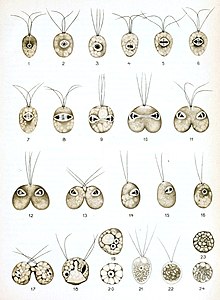| Polytomella | |
|---|---|

| |
| Polytomella agilis | |
| Scientific classification | |
| (unranked): | Viridiplantae |
| Division: | Chlorophyta |
| Class: | Chlorophyceae |
| Order: | Chlamydomonadales |
| Family: | Dunaliellaceae |
| Genus: | Polytomella Aragão |
| Species | |
Polytomella is a genus of green algae in the family Dunaliellaceae.[1] Polytomella is a free-living, flagellated, nonphotosynthetic green alga with a highly reduced, linear fragmented mitochondrial genome.[2][3] Polytomella, as it exists today, bears evidence of once having a functional photosynthetic plastid which has over evolutionary time changed such that it would appear now to have no genome or gene expressing mechanisms remaining to it.[4] Having transitioned completely to heterotrophy, Polytomella uses organic acids, alcohols and monosaccharides as its carbon source.[3][5][6] Despite being an evolutionary descendant of the green algae, Polytomella is a colourless organism because it has lost its photosynthetic ability.[6]
References
[edit]- ^ Guiry, M.D.; Guiry, G.M. "Polytomella". AlgaeBase. World-wide electronic publication, National University of Ireland, Galway.
- ^ Smith, DR; Lee, RW (2011). "Nucleotide diversity of the colorless green alga Polytomella parva (Chlorophyceae, Chlorophyta): high for the mitochondrial telomeres, surprisingly low everywhere else". The Journal of Eukaryotic Microbiology. 58 (5): 471–3. doi:10.1111/j.1550-7408.2011.00569.x. PMID 21762422.
- ^ a b Inwood, W; Yoshihara, C; Zalpuri, R; Kim, KS; Kustu, S (November 2008). "The ultrastructure of a Chlamydomonas reinhardtii mutant strain lacking phytoene synthase resembles that of a colorless alga". Molecular Plant. 1 (6): 925–37. doi:10.1093/mp/ssn046. PMC 2902904. PMID 19825593.
- ^ "Plant Phys". m.plantphysiol.org. Retrieved 2015-09-28.
- ^ Links, J.; Verloop, A.; Havinga, E. (December 1961). "Some growth experiments withPolytoma uvella on synthetic media". Antonie van Leeuwenhoek. 27 (1): 76–80. doi:10.1007/BF02538425.
- ^ a b Cruz, Vidal; Gittleson, Stephen (1981). "The genus Polytomella: A review of classification, morphology, life cycle, metabolism, and motility". Archiv für Protistenkunde. 124 (1–2): 1–28. doi:10.1016/s0003-9365(81)80001-2. Retrieved 25 September 2015.
Well, that’s interesting to know that Psilotum nudum are known as whisk ferns. Psilotum nudum is the commoner species of the two. While the P. flaccidum is a rare species and is found in the tropical islands. Both the species are usually epiphytic in habit and grow upon tree ferns. These species may also be terrestrial and grow in humus or in the crevices of the rocks.
View the detailed Guide of Psilotum nudum: Detailed Study Of Psilotum Nudum (Whisk Fern), Classification, Anatomy, Reproduction